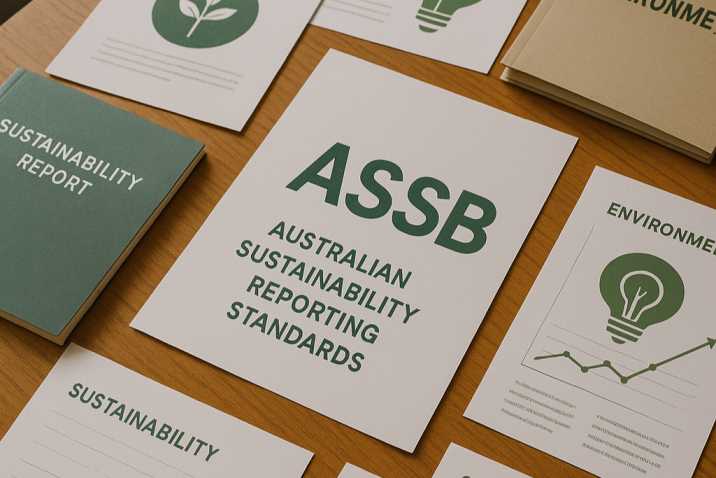Australian Sustainability Reporting Standards: Everything You Need to Know About AASB S1 & AASB S2

In this article, we break down the purpose and key requirements of the australian sustainability reporting standards (AASB S1 and AASB S2).
Mastering Climate Related Disclosures: A Comprehensive Guide to NZ CS 1, 2 & 3

Climate related disclosures related disclosures are rapidly becoming essential in both global and domestic reporting. This guide tells tou everything you need to know about NZ CS 1, 2, & 3.
Essential Guide for Transitioning to ISSB Standards for Sustainability Reporting

Transitioning to ISSB standards marks a pivotal moment for companies in Singapore striving to enhance sustainability reporting and align with global ESG expectations.
This guide provides a clear roadmap for navigating the shift, ensuring compliance while unlocking long-term value through transparent and consistent sustainability reporting.
EU Omnibus Explained: Delays, Threshold Changes, and What Comes Next

In this article, we break down the core elements of the CSRD Omnibus, including the new compliance timelines, updated reporting thresholds, and what these changes mean for companies navigating the EU’s evolving ESG reporting regime.
EU’s CS3D: Your Guide to the Corporate Sustainability Due Diligence Directive

Whether you’re asking, “What is CS3D?” or already mapping your supply chain for compliance, this guide will help you breaks down the CS3D directive.
The CSRD Explained: A Practical Guide for International Businesses in EU

The CSRD is reshaping the way businesses report on sustainability and ESG performance in Europe. For international companies operating within or doing significant business in the EU, understanding CSRD is critical. With mandatory disclosure requirements, greater transparency standards, and harmonized rules, the CSRD aims to create a level playing field and ensure that sustainability reporting holds the same weight as financial reporting. This guide breaks down what the EU’s guidelines on reporting climate related information (CSRD), who it affects, what needs to be reported, and when. We also cover key definitions and thresholds, so international businesses can stay ahead of compliance. What is CSRD? (CSRD Meaning) The Corporate Sustainability Reporting Directive is a European Union regulation that expands and replaces the Non-Financial Reporting Directive (NFRD). It mandates detailed sustainability reporting by companies operating in the EU, including some non-EU firms. It is essentially the European Climate Reporting Standard. The CSRD was adopted in December 2022 as part of the European Green Deal and the broader EU Sustainable Finance Agenda. Its main objective is to improve the quality, consistency, and comparability of sustainability reporting across companies and industries. This new framework requires companies to publish an annual CSRD report as part of their management report, following the European Sustainability Reporting Standards (ESRS) developed by EFRAG. Who Needs to Comply? (Reporting Threshold Pre Omnibus) As per the EU’s guidelines on reporting climate related information, the following companies need to publish sustainability reports under CSRD: Large EU companies meeting 2 of the 3 criteria below: Over 250 employees Net turnover of more than €50 million Total assets exceeding €25 million Listed SMEs, except micro-enterprises, with simplified standards and a transition period until 2028. Non-EU companies that: Have a net turnover of €150 million or more in the EU, And own at least one EU-based subsidiary or branch that meets CSRD thresholds. CSRD Timeline (Pre Omnibus) The CSRD timeline for publishing sustainability reports is as follows: Entity Type Reporting Begins Data Period Covered Large Companies under NFRD FY 2024 Reports due in 2025 Large EU Companies newly covered by CSRD FY 2025 Reports due in 2026 Listed SMEs FY 2026 Reports due in 2027 Non-EU Companies FY 2028 Reports due in 2029 Note: Voluntary adoption is encouraged before mandatory deadlines, especially to align with investor expectations and ESG-focused stakeholders. What Is CSRD Double Materiality Concept? Double materiality is a core concept in the CSRD Directive. It means that companies must assess and report on sustainability matters from two perspectives: Financial Materiality – How environmental, social, and governance (ESG) issues impact the company’s financial position and performance. Impact Materiality – How the company’s operations affect people and the environment. Under CSRD, both angles must be evaluated to provide a full picture of sustainability performance. This goes beyond traditional financial reporting and helps stakeholders better understand a company’s risks and impacts. This requirement applies to all in-scope companies and is central to the ESRS standards. Does CSRD Require Scope 3 Emissions Reporting? The CSRD requires disclosure of Scope 1, 2, and 3 greenhouse gas (GHG) emissions under the European Sustainability Reporting Standards (ESRS E1). Scope 1: Direct emissions from owned or controlled sources (e.g., company vehicles). Scope 2: Indirect emissions from purchased electricity, heat, or steam. Scope 3: All other indirect emissions in the value chain (e.g., supplier emissions, employee commuting, product use). For many companies, Scope 3 accounts for the largest share of total emissions, and the CSRD emphasizes transparency here. While data availability challenges are recognized, companies are expected to progressively improve their disclosures and estimation methods. What Are the ESRS (European Sustainability Reporting Standards)? To ensure consistency and clarity in sustainability reporting, companies must report in line with the European Sustainability Reporting Standards (ESRS). Developed by EFRAG (European Financial Reporting Advisory Group), these standards outline how and what companies must disclose regarding ESG (Environmental, Social, and Governance) issues. The ESRS are split into: 2 General Standards – providing foundational reporting principles and company-wide disclosures. 10 Topical Standards – grouped under Environment, Social, and Governance, focused on material risks, impacts, and opportunities. Companies are only required to report on data points that are material to them, based on their double materiality assessment. For example, a manufacturer may focus on ESRS E2 (Pollution), while a consumer-focused company may emphasize ESRS S4 (Consumers and End-Users). Note: Climate-related disclosures (ESRS E1) are presumed material by default. Companies must justify if deemed otherwise. ESRS 1: General Principles ESRS 2: General Disclosures Covers: Foundational sustainability principles and reporting concepts Covers: Governance, strategy, impacts, risks & opportunities, measurement, and objectives Environment Social Governance ESRS E1 – Climate Change ESRS S1 – Own Workforce ESRS G1 – Business Conduct ESRS E2 – Pollution ESRS S2 – Workers in the Value Chain ESRS E3 – Water and Marine Resources ESRS S3 – Affected Communities ESRS E4 – Biodiversity and Ecosystems ESRS S4 – Consumers and End-Users ESRS E5 – Resource Use and Circular Economy Reporting, Publication, and Assurance Format: Reports must be embedded in the annual management report and published in digital x HTML format on the company’s website, unifying financial and non-financial disclosures. Timeline: Annual publication, within 4 months of financial year-end. Audit: Reports must be audited by an independent party, starting with limited assurance and evolving to reasonable assurance by October 2028. SMEs: Simplified sector-specific standards are being developed for listed SMEs, with a two-year opt-out option. These standards aim not only to increase transparency, but also to embed sustainability into the heart of corporate strategy. What is Gap Analysis? Following the identification of material issues for the company and their associated indicators, the next step is to outline the data collection process in preparation for audit phases. This includes describing the data to be gathered: the scope covered, calculation methodology, level of detail, validation methods, etc. This initial selection and description of data enable the execution of a “gap analysis,” which involves identifying the gap between the information currently available and the reporting requirements. The process
Are Sustainability Reports Required in Singapore?

In this blog we discuss what is sustainabily reporting, why is it important and is it mandatory to publish sustainability reports in Singapore.
7 Sustainability Reporting Frameworks & Standards You Should Know

This blog aims to provide a comparison of sustainability reporting frameworks and standards and offer guidance on selecting a standard.
Publishing Sustainability Reports – Is it Mandatory in New Zealand?

In this blog we discuss what is sustainabily reporting, why is it important and is it mandatory to publish sustainability reports in New Zealand.

